生きた神経細胞の電気的活動を計測するバイオセンサ・チップをインフィニオンが開発
独インフィニオンテクノロジーズの研究陣が、マックス・プランク生化学研究所との協力により、生きた神経細胞を新開発のバイオセンサ・チップと直接接触させ、細 胞が発生する電気信号を読み取ることに成功しました。インフィニオンが「ニューロチップ(Neuro-Chip)」と名付けたこのブレークスルー技術は、科学研究者に、ニューロン(神経単位)、神経組織、有 機神経ネットワークなどの生物学的機能に関して新しい知見をもたらします。医薬品開発の分野で「ニューロチップ」は、生きたニューロン上で新しい薬剤調合の効果を試験することを可能にし、研 究の効率と生産性向上に寄与します。
インフィニオンは、半導体開発の世界フォーラムとして権威のある国際固体素子回路会議(ISSCC 2003)において「ニューロチップ」の開発を報告しました。その研究成果には、生 きたニューロンから発せられる電気信号を計測した初の報告も含まれています。インフィニオンのプロジェクト・パートナーで、バイオサイエンス研究の世界有数の研究機関として知らせるマックス・プ ランク生化学研究所との共同研究で、研究陣は、カタツムリの脳から採取したニューロンから発生される電気信号を記録しました。
ニューロンは、あらゆる生物の神経系を形成する特殊な細胞です。多くの付随する神経細胞で構成される神経組織は、脳と脊髄(せきずい)の重要な構成要素です。神 経細胞同士は電気的パルスを介して交信します。従って、コンピュータシステムでそれらの信号を読み取り、記録できれば、神経学的プロセスに新しい知見をもたらすことが期待されます。
インフィニオンのコーポレート・リサーチ・センターのバイオセンサ・チップ担当シニア・ディレクタであるローラント・テヴェス博士は、「信号対雑音比に関してこのチップは、基 本的な物理的限界に近いレベルで動作します。当社は、生化学および新薬研究にシリコン技術の長所を採り入れたバイオチップを開発するため、チップ生産で培った50年に及ぶ知識を活かせます。ニ ューロチップの開発で、当社は科学的理解を前進させる土台を築きました」と、語りました。
インフィニオンは、 「ニューロチップ」と付随する試験システムの開発に関して、2000年半ばからマックス・プランク生化学研究所(本部:ミュンヘン近郊のマルチンスリート)の 研究陣と協力しています。インフィニオンが主に半導体技術の開発を担当、マックス・プランク研究所がニューロンとチップのインタフェーシングに関する専門的ノウハウを提供しています。
マックス・プランク生化学研究所教授ペーター・フロムヘルツ博士は、「ニューロンと半導体のインターフェイスに関する長期の基礎研究がハイテクチップと出会ったことで、夢が現実となりました。イ ンフィニオンの先端マイクロエレクトロニクス開発は、バイオ薬品、バイオ技術、脳研究における新規アプリケーションの土台となるでしょう」と、語りました。
データの効率と精度を高める高密度センサ・アレイ
インフィニオンの「ニューロチップ」は、1平方ミリのエリアにアレイ状に128_128個のセンサを集積しています。各センサの下に巧妙な電子回路が組み込まれ、ニ ューロンが発生する極めて微弱な信号の増幅と処理を行います。個々のニューロンは、センサ・アレイ上の培養液に浸されます。培養液はニューロンを生きた状態に保ち、神経組織を再構築できるようにします。検 体サンプルの準備中にニューロンに損傷を与える従来の研究方法と異なり、「ニューロチップ」は数週間にわたって神経組織を乱さずに観察できるので、神経系や脳がどのように学習、処理、記憶するか、そ の機能を継続的に観察することができます。
インフィニオンの「ニューロチップ」のセンサ密度は、今日使われている通常のニューロン試験法(ニューロンとの接触に、ガラス基板上に真空蒸着した金属レーンを使用)の約300倍にのぼります。チ ップ上のセンサは、間隔8μmで配置されています。ニューロンの典型的なサイズは10~50μmなので、低密度で配列されたセンサでは信頼できる接触は得られません。「ニューロチップ」の高密度センサ・ア レイでは、サンプル内の個々のニューロンは、「ニューロチップ」の少なくとも1個のセンサには接触することになります。
各ニューロンを個別に順次チェックする代わりに、「ニューロチップ」では、複数のニューロンを同時に調べます。その結果、統計的により適切なデータが得られます。しかも、「ニューロチップ」は、所 定時間内における神経組織内の電気的活動の動作シーケンスを記録できます。「ニューロチップ」は16,384個のセンサがそれぞれ、毎秒2,000以上の信号値を記録できます。さらに、そ れらデータをカラー画像に変換して、ビジュアル解析を行うことができます。研究者はそのデータから、神経組織全体が所定時間内に、電気的刺激や特定の化学物質にどのように反応するかを検知することができます。
0.3平方センチのエリアで解析と評価
インフィニオンの「ニューロチップ」の全体寸法は、ニューロン信号の増幅と処理を行い、データをチップ外部へ転送するための回路部分を含め、5mm×6mmです。このチップは標準のCMOS( 金属酸化膜半導体)技術をベースとし、静電容量式センサ・アレイを実現するためのプロセス・ステップが追加されています。
インフィニオンが、極めて微弱な細胞信号を観察できる完全なICの開発に成功を収めたことは、世界的な技術ブレークスルーといえます。「ニューロチップ」は ピーク差100μV~5mVの範囲の電圧変化を検知し、処理することができます。
備考
発表原文および高解像度の報道写真は下記URLでダウンロードできます。
http://www.infineon.com/news/press/302_041e.htm
インフィニオンについて
インフィニオンテクノロジーズ(Infineon Technologies AG)は、ドイツのミュンヘンに本社を置き、自 動車および産業分野や有線通信市場のアプリケーションへ向けた半導体およびシステムソリューション、セキュア・モバイル・ソリューション、メモリ製品などを供給しています。米国ではカリフォルニア州サンノゼ、ア ジア太平洋地域ではシンガポール、そして日本では東京を拠点として活動しています。2003会計年度(9月決算)の売上高は61億5,000万ユーロ、2003年9月末の従業員数は約32,300名でした。イ ンフィニオンは、フランクフルトとニューヨークの証券取引所に株式上場されています。
Information Number
INFCPR200302.041e
Press Photos
-
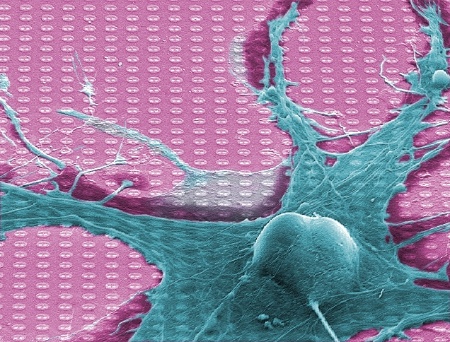 The "Neuro-Chip" from Infineon Technologies is connected with a living nerve cell. The Neuro-Chip's 16,384 sensors read the electrical activity of the cell. The typical size of neurons is between 10 - 50 micrometers (1 µm, a thousandth of a millimeter). Press Photo: Infineon Technologies, Max Planck InstitutePress Picture
The "Neuro-Chip" from Infineon Technologies is connected with a living nerve cell. The Neuro-Chip's 16,384 sensors read the electrical activity of the cell. The typical size of neurons is between 10 - 50 micrometers (1 µm, a thousandth of a millimeter). Press Photo: Infineon Technologies, Max Planck InstitutePress PictureJPG | 313 kb | 636 x 484 px
-
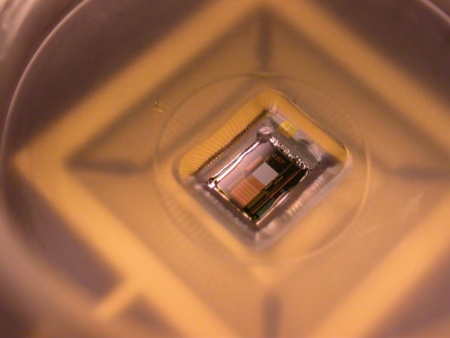 Microscopic zoom on the Neuro-Chip makes visible the sensor grid of 1 millimeter x 1 millimeter and the circuitry above which enables to record, amplify and process the more than 32 million information bytes presented by the 16,384 sensors on the grid every second. Press Photo: Infineon Technologies, Max Planck InstitutePress Picture
Microscopic zoom on the Neuro-Chip makes visible the sensor grid of 1 millimeter x 1 millimeter and the circuitry above which enables to record, amplify and process the more than 32 million information bytes presented by the 16,384 sensors on the grid every second. Press Photo: Infineon Technologies, Max Planck InstitutePress PictureJPG | 441 kb | 1600 x 1200 px
-
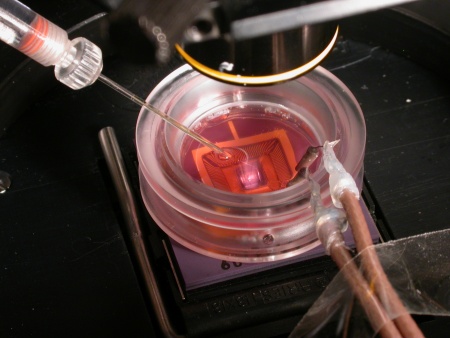 The microscope makes visible the sensor array and circuitry of Infineon's Neuro-Chip. Neurons are placed on the sensor array for further studying. Press Photo: Infineon Technologies, Max Planck InstitutePress Picture
The microscope makes visible the sensor array and circuitry of Infineon's Neuro-Chip. Neurons are placed on the sensor array for further studying. Press Photo: Infineon Technologies, Max Planck InstitutePress PictureJPG | 1.19 mb | 2272 x 1704 px
-
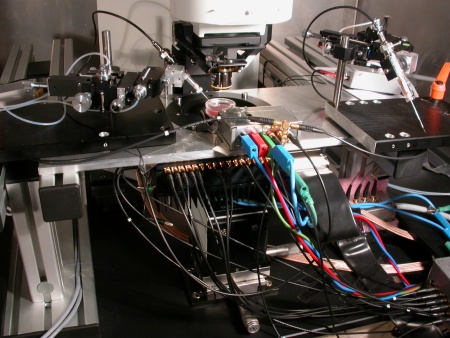 Infineon's Neuro-Chip records and amplyfies the electrical signals from nerve cells, so-called neurons, and transfers them to a computer system for processing. The data can then be transformed into a color picture for visual analysis. Researchers can detect from this data how complete nerve tissues react to electrical stimulation or certain chemical substances in a given period of time. Press Photo: Infineon Technologies, Max Planck InstitutePress Picture
Infineon's Neuro-Chip records and amplyfies the electrical signals from nerve cells, so-called neurons, and transfers them to a computer system for processing. The data can then be transformed into a color picture for visual analysis. Researchers can detect from this data how complete nerve tissues react to electrical stimulation or certain chemical substances in a given period of time. Press Photo: Infineon Technologies, Max Planck InstitutePress PictureJPG | 1.13 mb | 2272 x 1704 px
-
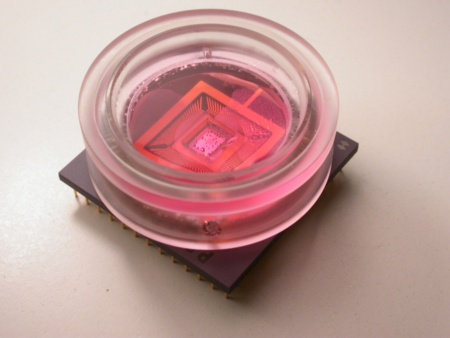 Individual neurons are placed into a nutrient solution above the Neuro-Chip's sensor array, which keeps the neurons alive and allows reconstruction of nerve tissue. Press Photo: Infineon Technologies, Max Planck InstitutePress Picture
Individual neurons are placed into a nutrient solution above the Neuro-Chip's sensor array, which keeps the neurons alive and allows reconstruction of nerve tissue. Press Photo: Infineon Technologies, Max Planck InstitutePress PictureJPG | 353 kb | 1600 x 1200 px
-
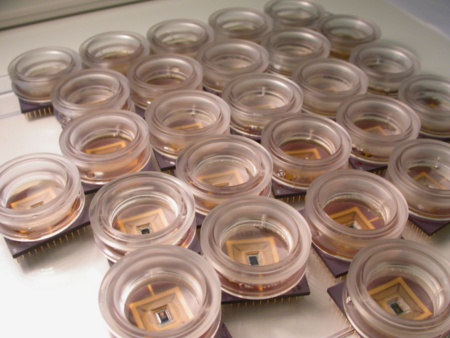 With 16,384 tiny sensors packed into one square millimeter and surrounded by processing circuits, each of these "Neuro-Chips" will be used to monitor the electrical activity of living nerve cells. Researchers at Infineon Technologies and the Max Planck Institute for Biochemistry developed the technology to gain insight into basic biological functions. Press Photo: Infineon Technologies, Max Planck InstitutePress Picture
With 16,384 tiny sensors packed into one square millimeter and surrounded by processing circuits, each of these "Neuro-Chips" will be used to monitor the electrical activity of living nerve cells. Researchers at Infineon Technologies and the Max Planck Institute for Biochemistry developed the technology to gain insight into basic biological functions. Press Photo: Infineon Technologies, Max Planck InstitutePress PictureJPG | 377 kb | 1600 x 1200 px
